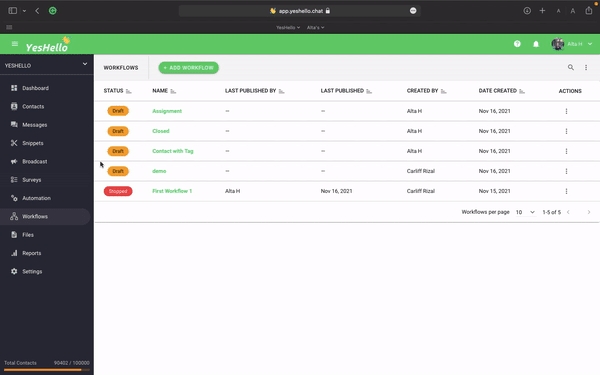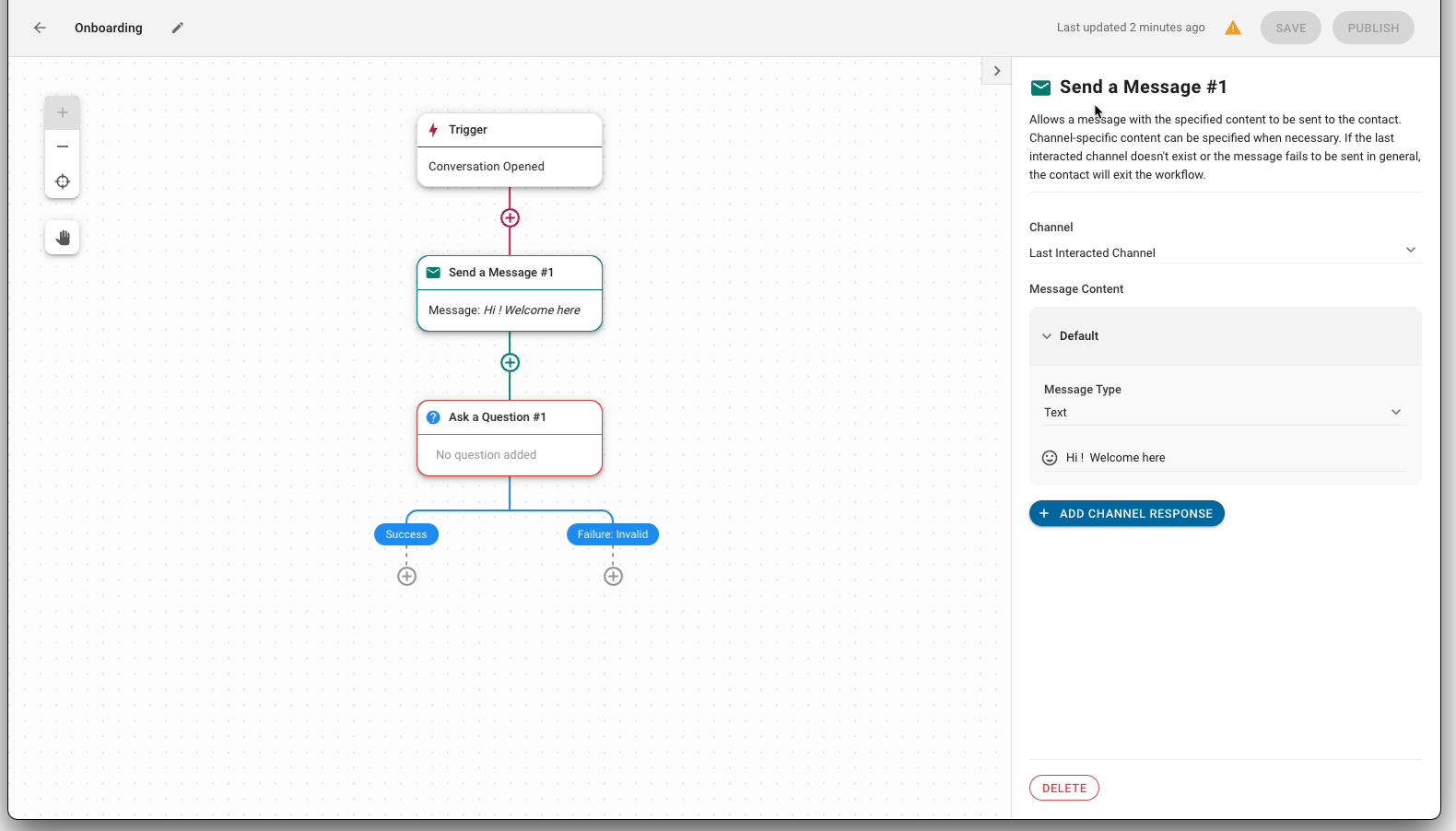Workflows
View, set up and manage Workflows.
This feature is currently in Beta.
Workflows is designed to replace Automations, Surveys, Away Message, Automatic Assignment and Greeting Message. These features will be deprecated in favor of Workflows.
Getting Here
This module is only accessible by Space Owners & Managers.
This module is accessed from the side navigation menu under the menu item Workflows.
The Workflows module is a visual workflow builder used to automate processes. Workflows are flexible enough to build automation related to Contact data, automated messaging, assignment & more. A single Workflow consists of a Trigger and one or more Steps.
Workflows Overview
Use the 🔍 at the top of the Workflows Module to quickly find a Workflow
The main page of the Workflows module lists all existing Workflows.
Workflow Columns
Each Workflow will have the following associated information in its columns.
Workflow Status
The Workflow Status is used to determine if the Workflow is currently running. There are 3 possible statuses:
Draft: a Workflow that has never been published
Published: a Workflow that is currently implemented
Stopped: a previously published Workflow that has been stopped
Other Columns
Each Workflow has additional columns detailed below.
Name | Displays the name & description |
Last Published By | Displays the user who published last |
Last Published | Displays the last publish date |
Created By | Displays the user who created it |
Date Created | Displays the date it was created |
Action Menu
The last column in the Workflow row contains the action menu. The following actions can be performed from this menu:
Publish Workflow | Only shown when Workflow is in Draft or Stopped |
Stop Workflow | Only shown when Workflow is Published |
Edit Name/Description | Allows editing of Workflow name or description |
Open in Builder | Opens the Workflow in the Builder |
Clone | Creates a duplicate Workflow in Draft Status |
Delete | Deletes the Workflow |
The Workflow Builder
Workflows are opened in the Workflow Builder. The Workflow Builder is a visual editor where Steps can be added, removed & configured. It consists of 4 main sections:
The Top Bar
The Top Bar is used to manage key items regarding the Workflow like the name, description, errors in step configuration, and the workflow's status. The elements of the Top Bar are listed below.
Name | Displays Name & allows editing Name or Description |
Error Indicator | Indicates a Step configuration error |
Save Button | Allows Saving the Workflow |
Status Button | Allows Publishing & Stopping the Workflow |
Assistive Tools
The Assistive Tools are designed to help you navigate the Canvas. It includes 4 tools:
Zoom In
Zoom Out
Back to 100% Zoom
Hold & Drag Canvas
Canvas
Canvas is the drag-and-drop interface that provides an overview of the Workflow. It allows the user to visually observe the logic and sequence of a Contact's journey during an event. Actions such as building new steps, dragging or dropping steps and connecting steps take place here.
Configuration Drawer
To configure a trigger or step, click on the block to open the configuration drawer. There are a few actions available within the configuration drawer: Edit the step name, Define the action of the trigger event or step and Delete the step.
Managing Workflows
Creating a Workflow
To create a Workflow:
Navigate to the Workflows Manage
Press Add Workflow
Name the Workflow
Press Create
Once the Workflow has been created it will open in the Workflow Builder.
Saving a Workflow
Step configuration errors must be resolved before a Workflow can be saved.
A Workflow can be saved by pressing the SAVE button in the Top Bar of the Workflow Builder.
Resolving Workflow Errors
If a step in the Workflow is configured incorrectly a ⚠ sign will appear. Hovering over the icon will show the steps which have configuration errors. Pressing on the step will take you directly to the step and open the configuration drawer.
Publishing a Workflow
To start a Workflow you will need to publish it. A Workflow can be published from 2 places:
From the Action Menu in Workflows Overview
Using the Publish Button inside the Workflow Builder.
Once the Workflow is published any Contacts that meet the Trigger criteria will enter the Workflow. Before editing a Published Workflow you will need to stop the Workflow.
Stopping a Workflow
When a Workflow is stopped, all enrolled Contacts will be ejected immediately. They will not be re-enrolled into the Workflow when re-published.
A Workflow can be stopped from 2 places:
From the Action Menu in Workflows Overview
Using the STOP Button inside the Workflow Builder.
Once a Workflow is stopped, it may be edited.
Editing a Workflow
A workflow can only be edited when stopped.
Editing a Workflow required entering the Workflow Builder. You can Open in Builder from the Action Menu in Workflows Overview. Once inside the Workflow Builder you can edit the Workflow.
Frequently Asked Questions
What will happen to my Contacts if I stop a Published Workflow?
If a Workflow is stopped, all enrolled Contacts will be immediately ejected from the Workflow. They will not be re-enrolled into the Workflow if it is re-published.
Why is the contact field not updating saved responses?
Invalid responses, such as responses in the wrong format, cannot be saved. Clearly specify a response format when asking a question. Refer here for the correct format of each type of response.
Why did my Workflow end before it was completed?
A workflow may end prematurely for the following reasons:
The Workflow was stopped
If a Workflow is stopped, all enrolled Contacts will be immediately ejected from the Workflow.
The Contact fell under the Failure Branch and there was no continuing journey
Contacts may fall under a Failure Branch if they provide invalid responses or do not meet specified conditions. If there are no steps configured under the Failure Branch, the Workflow will end. It is advisable to configure steps under the Failure Branch so Contacts may continue their journey if they land here.
Ask a Question - Timeout
The Ask a Question Step has a default timeout period of 7 days. If Contacts do not respond within the defined or default timeout period, the Workflow will end. It is advisable to create a Timeout Branch and add steps for Contacts to continue their journey in the event of a timeout. Read more about the Ask a Question step here.
Assign to - Timeout
The Assign To Step has a default timeout period of 7 days. If an assignee who fulfills the assignment logic cannot be found within the defined or default timeout period, the Workflow will end. It is advisable to create a Timeout Branch and add steps for Contacts to continue their journey in the event of a timeout. Read more about the Assign To step here.
Branch Condition - Else
Contacts who do not meet the required conditions of a branch will fall under the Else branch. If no steps are configured under this branch, the Workflow will end. It is advisable to configure steps under the Else branch so Contacts may continue their journey if they land here. Read more about branch steps here.
Send a Message - Fail
If a message is not sent for any reason (e.g. messaging window closed, network connection issues), the Contact will exit the Workflow.
If I add an Ask a Question step after the Conversation has closed (e.g. Close Conversation step or Conversation Closed trigger), will the Conversation reopen if the Contact responds?
No, a Contact will not reopen the Conversation by responding to the 'Ask a question' step.
What happens is there is no one in an Assign To team?
The Contact will not be assigned and will move on to the next step.
If I manually close a Conversation with an enrolled contact, will the Workflow end?
No, the Workflow will continue even if the conversation is manually closed.
What if a Contact triggers more than one workflow at the same time?
Both Workflows will be executed concurrently.
Last updated



